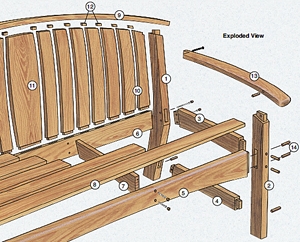What Is the Actual Thickness of 5 4 Lumber

What do measurements like 8/4, 6/4, 5/4 and 4/4 mean?
In an outdoor bench project, I've seen the measurements of 6/4, 5/4 and 4/4 and don't quite know what it means. I have asked around and have gotten some explanations, but am still confused as to how to reach those measurements. Is it that you have to glue boards together to get the over-sizes? And why would anyone want to confuse the general public with these rarely mentioned measurements? Please explain. Thanks. - Martin Heuer
Rob Johnstone: The "quarter system" is a metric for roughsawn lumber. It simply refers to how many 1/4-inches thick the rough stock is. For example, 4/4 (read out loud as four-quarters) is 1-in. thick in the rough. 5/4 is 1-1/4-in. thick, 12/4 would be three inches thick. If you surface rough stock smooth, you will usually lose about 1/4-in. of material. So, as a rule of thumb, 4/4 stock surfaces down to 3/4-in.-thick lumber and 5/4 to 1-in. thick. Curiously, the convention is that once lumber is surfaced, you use the actual thickness. For example, 1-1/2-in. surfaced rather than 6/4 rough. And for that reason, thicknesses like 3/4-inch, 1/2-inch, 5/8-inch surfaced do not use the quarter system metric. The convention is quite common to professional woodworkers, especially those working in hardwood lumber, though less common in the hobbyist woodworking press. I'm sorry that you find it confusing, but now you will be totally "in the know" and can start tossing lingo like "six-quarter white oak" left and right.
Chris Marshall: Woodworking has its share of jargon, but the quartering system isn't a passing fancy. When you shop at a specialty lumber supplier (not a home center, contractor's lumberyard or hardware store), you'll see that the quartering system is the standard by which stock will be thicknessed and sorted for sale. Good news is, as Rob points out, figuring actual "tape measure" thickness is pretty simple math. And, there aren't that many quartered thicknesses to worry about anyway. In a nutshell, you'll find 4/4, 5/4 (sometimes), 6/4, 8/4, 12/4, and, rarely, even 16/4. So, thicknesses translating to roughly 1-, 1-1/4-, 1-1/2-, 2, 3- and 4-in. Four quarter and 8/4 are most common, in my experience.
Tim Inman: These dimensions are very common among woodworkers and lumber folks. A 6/4 board is called out as "six-quarter" lumber, which means the board was 1-1/2-in. thick when it was cut from the green log. A 4/4 board is called out as "four-quarters," which was a 1-in.-thick board when it was cut. Why? It goes back to the sawmills. Sawmills that cut the lumber from logs are set up to increase the board thickness in quarter-inch jumps. When the sawyer cuts the log, there is a lever or handle he/she can pull that ratchets the log ahead of the blade. Four pulls is four quarters, six pulls measures out a 1-1/2-inch board, or "six quarters." They don't do 1/8-in. increments, and sawyers aren't interested in converting measured fractions to carriage clicks. You want a one and one-quarter inch-thick board? Then you get 5/4 or 5 clicks on the log sled. Each time the log returns to the starting point after it has passed the blade, the sawyer pulls the lever and the log advances across the carriage to cut the next board off, four clicks to the inch. For efficiency, the handle can be pre-set so the sawyer doesn't have to count clicks each time, but that is the basis of "quarter" calling lumber.
What Is the Actual Thickness of 5 4 Lumber
Source: https://www.rockler.com/learn/what-does-quarter-system-of-lumber-thickness-mean